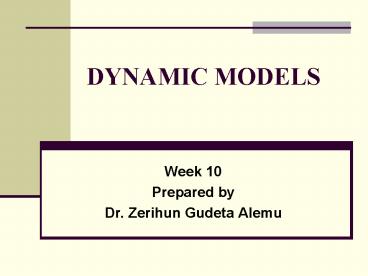DYNAMIC MODELS - PowerPoint PPT Presentation
1 / 12
Title:
DYNAMIC MODELS
Description:
B) Autoregressive Models: if a model includes one or more past values of the ... Assume all 's have the same sign and that the lag structure is infinite ... – PowerPoint PPT presentation
Number of Views:332
Avg rating:3.0/5.0
Title: DYNAMIC MODELS
1
DYNAMIC MODELS
- Week 10
- Prepared by
- Dr. Zerihun Gudeta Alemu
2
TYPES OF DYNAMIC MODELS
- A) Distributed-lag Models if a model contains
both the current and past (lagged) values of the
explanatory variables. - Yt ? ?0Xt ?1Xt-1 ?kXt-k ut
- B) Autoregressive Models if a model includes one
or more past values of the dependent variable
among its explanatory variables. - Yt ?0 ?1Xt ?2Yt-1 vt
- C) Causality Relationship between two variables
can be unidirectional, bidirectional, and neither
bilateral nor unilateral (i.e. independence).
3
A) DISTRIBUTED LAG MODELS
- Finite versus infinite distributed lag models
- Yt ? ?0Xt ?1Xt-1 ?kXk ut Finite
model - Yt ? ?0Xt ?1Xt-1 ut Infinite
Model - ?0 is short run multiplier ?0 ?1 ?3 .. ?k
give interim - Multiplier ? ?I ? if ? exists is long-term
multiplier. - Problem of estimation No guideline as to the
maximum - length of the lag. A bottom-up approach (adding
lags until - insignificant or one of explanatory variables
sign changes) - is commonly used. This result in fewer degree of
freedom, - multicollinearity problem and data mining
4
Koyck Model An example of distributed lag model
- Assume all ?s have the same sign and that the
lag structure is infinite - ?k ?0?k , k 0, 1, 2, 0 ? ? ? 1
- ? ? rate of decay 1 - ? ? speed of adjustment.
- i.e. effect of lagged Xs is geometrically damped
as lag increases - ?s cant change sign (0 ? ?)
- less weight to distant ?s (? ? 1)
- Sum of ?k up to infinity ?0(1/(1-?))
5
Koyck Transformation
- Yt ? ?0Xt ?0?Xt-1 ?0?2Xt-2 ut (i)
- lag (i) by one period and multiply by ?
- ?Yt-1 ?? ?0?Xt-1 ?0?2Xt-2 ?0?3Xt-3
?tut-1 (ii) - subtract (ii) from (i)
- Yt - ?Yt-1 ?(1 - ?) ?0Xt (ut - ?ut-1)
(iii) - or
- Yt ?(1 - ?) ?0Xt ?Yt-1 vt
(iv)
6
Koyck Model (Cont)
- Equation (iv) is an AR (autoregressive) model
- Yt-1 is a stochastic regressor (this violates
CLRM assumption why?) - vt is autocorrelated if ut is not why?
- Durbin Watson test statistic is not appropriate
to test for the presence of fist order
autocorrelation instead Durbin H is used for
large samples. h statistic is asymptotically
normally distributed with zero mean and unit
variance recall P(-1.96 ? h ? 1.96) 0.95The
7
Koyck model (Cont)
- Interpretation
- Median Lag
- ? time required for 50 of total ?Y following a
unit sustained ?X - e.g. Koyck Med Lag
- so ? ? ? lower speed of adjustment ( longer
median lag) - Mean Lag
- ? weighted average of all lags (lag-weighted
average of time) - If ? 0, mean lag
- e.g. Koyck Mean lag
- ? ? ? lower speed of adjustment ( longer mean
lag) - Koyck transformation is a useful mathematical
device. In practice it is rationalized using
appropriate theoretical underpinnings from
Adaptive Expectation or Partial Adjustment
Models.
8
Adaptive Expectation (AE) Partial Adjustment
Models (PAM)
- Koyck model is devoid of any theoretical
underpinning. - AE and PAM Applied in Agricultural Supply
Response Analysis. - Assume we want to estimate the responsiveness of
maize producers to incentive changes. - If AE theory is used, maize output is expressed
as a function of expected price. - If PAM is used, desired level of maize output is
expressed as a function of actual price.
9
B) Autoregressive Models
- The following are requirements
- Stochastic explanatory variables (i.e. Yt-1) must
be independent of vt . - Test for serial correlation must be conducted
using Durbin H test. - Yt-1 is correlated with vt by construction
(why?), so OLS yields biased and inconsistent
estimators. - To solve the latter problem, instrumental
variables (Zt,) may be used as a proxy for Yt-1.
Zt must be highly correlated with Yt-1 but
uncorrelated with vt.
10
C) Granger Causality
- Here we are interested in the investigation of
the direction of causality between two variables,
say, price of a certain agricultural product (Pt)
and demand for the same product (Dt). - Pt Granger-causes Dt if lagged Pts help predict
Dt (when demand is regressed on its own past
values/lags).
11
Granger Causality
- Four Possible cases
- P ? D (unidirectional
causality) - D ? P (unidirectional
causality) - Bilateral causality All sets of
coefficients are significant - Independence Not significant
12
Granger Causality (cont)
- Steps to test for granger causality
- a) Regress Dt on lagged Dt to obtain restricted
RSSR. Lag length may be determined based on AIC
or SIC criteria. - b) Regress Dt on lagged Dt and lagged Pt to
obtain unrestricted RSSUR. Lag length may be
determined based on AIC or SIC criteria. - c) H0 Pt does not Granger cause Dt
- H0 lagged Pt terms are insignificant
- d) Fm, n-k k is
the of parameters in UR regression - e) If Fcalc ? Fcrit then reject H0 ? lagged P
terms are significant, ? P does Granger-cause GDP - f) Repeat with P regressed on D to test H0 D
does not Granger cause P































